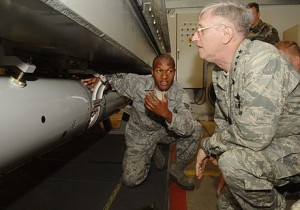U.S. - Russia Tensions Escalate Over Deployment of Nuclear Weapons in Germany
[dropcap]Tensions[/dropcap] between Russia and the United States increased in recent weeks after the U.S. began preparations to station additional nuclear warheads and upgrade its nuclear arsenal in Germany. As relations between the two countries have reached historic lows in the past year, experts worry that America’s decision to build up its nuclear capacity in Europe may ignite an arms race.

After the breakup of the Soviet Union in 1991, the United States removed approximately 90 percent of its nuclear capacity from continental Europe. However, the remaining 10 percent has been critical to maintaining a strong NATO alliance and deterring adversaries within striking distance such as Russia and Iran.
Furthermore, many argue that American nuclear weapons in Europe help prevent proliferation by convincing American allies that they don’t need nuclear weapons to ensure their security.
The U.S. is currently developing a new variant of a traditional nuclear warhead, the B61, called the B61-12. The new model is more accurate, but carries a smaller payload. Proponents of the B61-12 argue that the reduced explosive power would make them less destructive, while the increased accuracy would make them more tactically effective. Critics argue that in practice, the reduced power would make leaders less hesitant to use them, resulting in the higher likelihood of starting a full-scale nuclear crisis than other types of warheads.
According to Bruce Gagnon, Coordinator of Global Network Against Weapons, by upgrading its nuclear arsenal in Germany, the U.S. is deliberately creating tension between Europe and Russia and attempting to sever any political or economic ties between Russia and EU members. Gangon says, “What we need is for Moscow to make stronger direct appeals to the people of Europe and beyond to oppose the US attempts to control the world economically and militarily.”
The Russian government, as well as others, believe that the United States is violating the Nuclear Non-Proliferation Treaty (NPT), which forbids nuclear-armed states from transferring nuclear weapons to non-nuclear states.
Director of the Nuclear Age Peace Foundation Alice Slater says, “[The Obama administration is] now actually upgrading the weapons and deliveries systems at bases in those countries hosting the illegal U.S. instruments of death and destruction on their soil, even though those five non-nuclear weapons states signed the NPT and promised never to acquire nuclear weapons."
The question of legality revolves around whether Germany, a signatory of the NPT, is considered to be acquiring the B62-12, or whether the weapons still belong to the US. Since NATO, rather than Germany, holds the ultimate authority over their use, most would argue that the recent move is legal.
To counter the threat, Russian officials are contemplating moving a number of the Russian Iskander ballistic missiles to a base in Kalingrad, close to continental Europe.
Maria Zakharova, spokeswoman for the Russian Foreign Ministry says, “such U.S. plans call for concern … in Europe, not just in Germany, but also in Belgium, the Netherlands, Italy, and Turkey, U.S. tactical nuclear armaments remain deployed. The Americans are modernizing their aerial bombs, and the NATO European members are modernizing their aircraft[s] that carry these weapons.”
While the Russian government has yet to determine how, or whether, it will respond, moving nuclear warheads to Kalingrad could provoke significant countermeasures from the U.S.. This could signal the start an arms race reminiscent of the Cold War era. An arms race could have devastating long-term consequences in the event of a U.S.-Russia conflict, which, after the Ukraine Crisis, seems increasingly possible.
